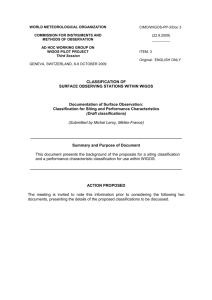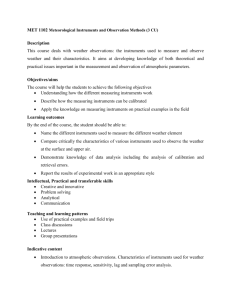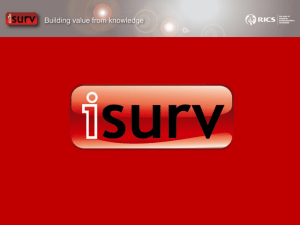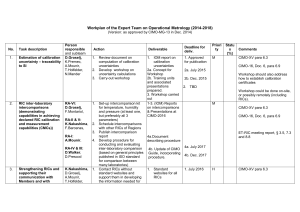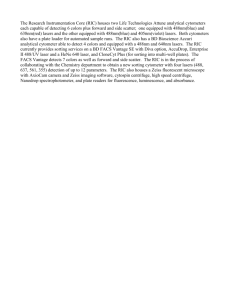Improvement of the quality of climatic and meteorological
advertisement
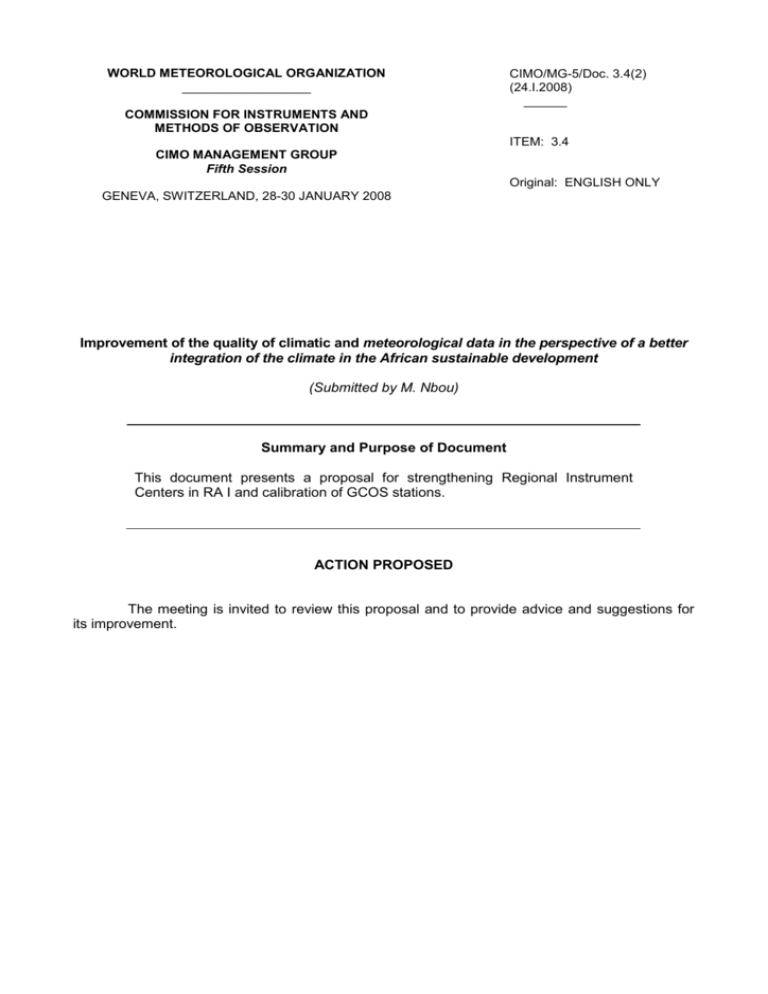
WORLD METEOROLOGICAL ORGANIZATION __________________ CIMO/MG-5/Doc. 3.4(2) (24.I.2008) ______ COMMISSION FOR INSTRUMENTS AND METHODS OF OBSERVATION ITEM: 3.4 CIMO MANAGEMENT GROUP Fifth Session Original: ENGLISH ONLY GENEVA, SWITZERLAND, 28-30 JANUARY 2008 Improvement of the quality of climatic and meteorological data in the perspective of a better integration of the climate in the African sustainable development (Submitted by M. Nbou) Summary and Purpose of Document This document presents a proposal for strengthening Regional Instrument Centers in RA I and calibration of GCOS stations. ACTION PROPOSED The meeting is invited to review this proposal and to provide advice and suggestions for its improvement. CIMO/MG-5/Doc. 3.4(2), p. 2 Kingdom of Morocco -----------------------National Meteorological Service of Morocco Improvement of the quality of climatic and meteorological data in the perspective of a better integration of the climate in the African sustainable development Traceability Project -- DRAFT PROJECT PROPOSAL: version 1 -September 2007 Technical Division and of equipment Service of Instrumentation and meteorological Observing Systems CIMO/MG-5/Doc. 3.4(2), p. 3 I. General considerations: I.1. Introduction: The meteorological and climatic observation data constitute the source of all meteorological services and products. Indeed, they form the basis element for the weather and climate forecasting, early warning to natural disasters and climate change and also for the studies concerning the climate impacts on the environment and economy. The influence of these data on the socioeconomic development of nations has been demonstrated many times and in several countries. In Africa, the strong vulnerability to the natural disasters and to the droughts as well as the big dependence of the population to the agricultural sectors, the environment, water and health, should make the observation and the meteorological watch an inescapable tool of help to the resources management, to the prevention of the extreme phenomena and to the decision making concerning the sustainable development of the countries. The sources of these meteorological measures and climatic data are the NMHS1 and GCOS2 observing networks including surface and upper air observing systems. These systems insure the role of the permanent monitoring of the weather that guaranties the availability of a representative and reliable data allowing an efficient exploitation. There has been a major decline in the number of climate observing stations in Africa over the past 40 years. While this has been compensated, to some extent, by the development of operational weather satellites covering Africa, adoption and use of these new technologies in climate applications has been slow. Despite the GCOS efforts, the basic meteorological and climatic network is still so sparse that it will be difficult to detect and quantify climate change trends in some areas, let alone inter-annual variability. The report of the IRI 3 , presented at the conference of ADDIS ABABA-April 2006, mentioned clearly that climate information is very important for achieving the Millennium Development Goals and other development targets "much better management of climate variability in a number of key sectors is essential to achieve the Millennium Development Goals and Sustainable Development in Africa". For this purpose, it is necessary to have reliable and regular data translating the state of the atmosphere and the evolution of the climate. I.2. The Problematic: While national economies and societies around the world are generally developing well, poverty is widespread in much of Africa, and getting worse. Africa as a whole, with a population of some 813 million people in 2002, seems largely to be missing out on development, let alone sustainable development. Part of the problem lies with the large number of rural people dependent on subsistence agriculture for their livelihoods. Too many such people have inadequate land with poor soils and marginal climates, and consequently their livelihoods are extremely vulnerable to climatic fluctuations. In the countries of the Sahel, for example, 80% of the population depends on the agricultural sector. However, this sector, with the lack of important technical and financial means, remain tributary of the precipitations regularity and quantity, the temperature variability and a lot of other meteorological factors. In some countries, the epidemics propagation management by the public health services needs very precise meteorological information for its success, as well as for the management and optimization of water resources becoming more and more rare or for the natural disaster prevention. However, the capacity of the NMHS doesn't permit, in the majority of the cases, an efficient respond to these needs and demands more and more accentuated. In fact, it is well noted that adequate high quality data for a variety of climate-related purposes is not available in many 1 National Meteorological and Hydrological Services Global Climate Observing System 3 International Research Institute for climate and society 2 CIMO/MG-5/Doc. 3.4(2), p. 4 countries due to insufficient geographic coverage, the low quantity and quality of the data produced by current global and regional observing systems, and the failure to rescue available historical data. These problems are especially acute in Africa, where lack of funds for modern equipment and infrastructure, inadequate training of staff, the high costs of continuing operations, and problems associated with political instability and conflict are often major constraints. A strengthening of NMHS and partnership observing networks in Africa was highly advised by international organisms and meteorological institutions (WMO 4 , GCOS, COP 5 …). This reinforcement can be achieved using the following means: A modernization of the instrumental park and the data storage and analysis tools, An improvement of the data quality and traceability by the mean of calibration, Improving communications to be able to deliver meteorological and climate services. As suggested by the IRI report, the Strengthening the observation network is only one side of the coin. If the collected data is not properly quality controlled and presented in a format that encourages stakeholders to use the data, the outcome of such initiatives will be much less than the potential. The first goal was the object of several projects and action plans proposed by the regional groups of the GCOS (GCOS-ECA report of Addis Ababa conference). However, the quality insurance and the traceability stays, up to day, on the secondary order, even though it has been referred to in nearly all reports and established projects in this context. The CIMO6 noted in this context that numerous NMHSs do not calibrate the instruments that they use regularly, or do not follow the international norms of standardization (According to the results of the questionnaire on the maintenance and instruments calibration distributed to the WMO Members on May 22, 2006). Four Regional Instrumentation Centers (RIC) were established in Africa as a result of the recommendation of the IXth session of CIMO. Their mission is to keep a set of meteorological standard instruments linked with recognized international or national standards, to assist the other countries in calibrating their national standard meteorological instruments and to advise them on their enquiries regarding instrument performance and the availability of relevant guidance material. On regards to the latest evaluating report on RICs, the XIIIth and the XIVth sessions of CIMO recommend the strengthening of RICs in particular those in developing countries to allow them to play their promoting role of data quality insurance. Morocco was introduced, as the fifth RIC for Africa, during the XIVth session of the regional council of the WMO for Africa (Ouagadougou, February 2007). In addition, The CIMO at its 14th session insisted on the importance of the standardization and the traceability guaranteeing a reliable data: "The commission agreed that the improvement of the quality and the international compatibility of the data depended strongly on the traceability of the measures in relation to the standards of the international unit system". RICs are considered as a key component of the GEOSS7. Furthermore, the WWW8 admit the contribution of RICs in natural disaster prevention: "the commission (CBS) estimates that the RIC would contribute considerably to the prevention of the natural disasters and the attenuation of their effects, as well as to the world system of the earth observation systems". The RICs in Africa should be the most efficient mean to insure observed data of high quality as they were created to control the instruments standardization as well as the traceability of the measures. This role influences on the whole value chain of the meteorological products. However, these organisms, in their present state, don't permit to 4 World Meteorological Organization Conference of the Parties on Climate change 6 Commission of Instruments and Methods of Observation of WMO 7 Global Earth Observing System of Systems 8 World Weather Watch 5 CIMO/MG-5/Doc. 3.4(2), p. 5 play this role as required, seen the weakness of their means and the difficulties in relation with the maintenance and the transfer of the standards, from which the interest of the present project. I.3. Justification: This project aims to improve the NMHS and GCOS observing networks in Africa in matter of standardization and traceability of their meteorological instruments. This will guarantee high quality measurements as required. One key suggested by the conference of ADDIS ABABA is the establishment of integrated regional efforts: “Observations for national to global purposes require networks owned and supported in partnership…Integrated regional centers (possibly virtual) will be required to organize and share knowledge required for multi-disciplinary products and services for development stakeholders in cost-effective and sustainable ways”. Consequently, the goal of the present project could be achieved by strengthening RICs. In fact, the terms of reference of the RIC includes: traceability, partnership and share in matter of training, advice and documentation (cf capabilities and function- annex B). The starting point for the achievement of this project is based on the recommendations of Addis Ababa conference concerning the improvement of the reliability of the observation data and those of the CIMO concerning the reinforcement of the RIC for a better control of the respect of standardization and traceability. We notes that the Addis Ababa Conference advised, in order to fill the gaps identified in weather observation and climate data in Africa, to improve the density and the quality of NMHS and GCOS observing networks for more available and high quality measurements. On the other side, the executive council of WMO and the CIMO are convinced that RICs have a great role in data quality insurance. As a consequence, RICs should be strengthened to achieve their mission at regional level. The reinforcement should be procured in four big domains: a) Setting up of laboratories and purchase of standardization devices; b) Quality Insurance and control; c) Training; d) Assessment of the RIC. II. Objectives of the project: The improvement of the climatic and meteorological data quality of the African GCOS and NMHS observing networks would strongly benefit from a stronger engagement of the Regional Instrumentation Centers (RICs) that plays the role of link between the local measurement instruments and the international standards. To really assume this role, these centers must have appropriate financial and human resources. The main objective is: To calibrate and to achieve traceability of GCOS ground based observing stations Thus, the present project sets four essential goals: To reinforce the material capacities and human knowledge of the African RIC and to improve their technical procedures to allow them to accomplish their task of calibration in link to recognized international chain. These centers suffer, currently, from several problems in relation with the lack of means (standards, calibration equipments, qualified staff, certified procedures and documentation …). To reinforce cooperation and partnership between RICs of CR-I and with RICs of advanced countries with the aim to encourage sharing knowledge in the matter and also to develop complementarities between RICs especially in domain of specialization. CIMO/MG-5/Doc. 3.4(2), p. 6 To conduct laboratory calibrations of national standards received in each RIC and in particular of GCOS instruments, and to achieve in site calibration and comparisons. To organize professional trainings for RIC staffs concerning the practices of standardization, calibrating methods and measurement traceability systems. Furthermore, special workshops and symposiums should be organized in order to sensitize the NMHS calibration laboratory responsible and GCOS observers on the importance of standardization, calibration, intercomparison, instrumentation and methods of observation. III. Concept of the project : Committees and Institutions on charge of the projects: A committee of Direction includes representatives of GCOS secretariat, CIMO secretariat, the president of the Regional Council of CR-I and the Chair of OPAG- capacity building of CIMO; A piloting and coordination committee constituted of representatives of the African RICs and WMO experts or responsible of developed RICs; An evaluating committee formed by two (or three) independent WMO experts; RICs of CR-I. The achievement of the project will be based upon the following points: A committee of Direction designates the members of the piloting and coordination committee and those of the evaluating committee, decide of the beginning of the project, validate and approve reports of the piloting and coordination committee concerning each phase of the project. CIMO/MG-5/Doc. 3.4(2), p. 7 A piloting and coordination committee will be in charge of achieving and insuring control of this project. The piloting committee will define the principal phases for the execution of the project, follow the execution of all stages and elaborate assessment reports for each phase. The evaluating committee is involved at the end of each phase and especially at the end of the project. It will be in charge of validating assessment reports of the piloting and coordination committee, making remarks, orientating and giving advice to the committee of Direction. The piloting and coordination committee will conduct an identification of the existing facilities in the RICs, the material needs, the level of knowledge of RIC Staffs. This identification will be achieved through questionnaires, meetings and visits. The strengthening of the RIC facilities include standards, calibrating equipments and staff training, as well as the development of quality management procedures (in order to help RICs in their future preparations to get the accreditation for ISO 17025 standard). The piloting and coordination committee will discuss the opportunity to have specialized centers for one or more observed parameters (pressure, temperature, humidity, radiation, precipitation and wind). The piloting and coordination committee will conduct an identification of the existing instruments implemented in GCOS surface networks in Africa. This will allow establishing a list of instruments that could be calibrated in laboratory, those on site and instruments that necessitate especial materials. This identification will be achieved through GCOS documents and questionnaires. The piloting and coordination committee will develop a first assessment report analyzing the actual state of RICs of CR-I and GCOS surface network. The reports will specify realistic proposals for upgrading RICs locals and equipments, organizing training actions (topics, duration, program…) and a first plan for conducting calibration activities. The piloting and coordination committee will develop and write technical documents including technical characteristics of standards, calibrating equipments and appropriate software to be acquired. Maintenance plan should be developed for each RIC taking into account the new equipments and the recommendations of constructors. Training and sensitization workshops in French and English languages should be organized for trainees and some GCOS observers with the participation of international experts. The training will be focused on standardization and calibration techniques as well as its importance in strengthening meteorological services in Africa. Experts of the WMO will be invited to animate these seminaries witch will insure a bigger contribution of the international experience for the benefit of the participants. The committee has to specify the frequency of the events, to study the issues and proposal of each event and to identify concerned organizations. CIMO/MG-5/Doc. 3.4(2), p. 8 Calibration and control of some measurement instruments of the whole GCOS observation network in Africa. This operation will be achieved by the mean of laboratory and on-site calibrating interventions. This operation should be achieved and supervised by RICs. The project will be implemented over a period of 3 years. IV. Project planning: IV.1. Stage 1 : Coordination and preparation It is a stage that will be achieved over a period of about 6 months and that will be dedicated to the following points: Coordination and preparatory activities (piloting committee designation, visits and contacts, looking for existing documents and elaborating questionnaires…) Analysis of the actual African GCOS network state concerning data reliability using documents and reports previously elaborated or by establishing of a questionnaire. The objective is to prepare a database of instruments used in this network. Analysis of the RICs actual facilities, existing partnerships, technical and administrative limitations in order to identify needs considering also the type of instruments used in the GCOS and NMHS calibrating laboratories. Preparation of the training programs, sensitization actions and coordination contacts necessary to the launching of the following stages. IV.2. Stage 2: Training and sensitisation The training and sensitization stage will be concretized in what follows: Organization of seminaries and training courses for trainees in Metrology and calibrating methods. Organization of trainings for the benefit of the RICs staff concerning procedures of calibration, data traceability system and maintenance procedures taking into account new purchased equipments Sensitization of some observers of the GCOS surface network to the importance of the observed data quality for a better recognition of the role of the climate in the socioeconomic development plans. This action could be scheduled for the whole period of this project. IV.3. Stage 3: Strengthening of the RICs This stage is very important for the success of the project. It will be achieved over 18 months and aim the following objectives: CIMO/MG-5/Doc. 3.4(2), p. 9 Definition of needs of each RIC taking into account the actual state of standards and calibrating equipments and also the type and nature of instruments used in the GCOS surface network and NMHS calibrating laboratories, Establishment of notes and technical prescriptions, following the identified needs, and the acquisition and purchase of adequate standards for the meteorological measurement range. Every RIC must have its own standards, for the chosen parameters, linked to the international metrological chain. Some calibrating equipments such as wind tunnel shouldn’t be purchased for all the RICs seeing its expensive cost. Appropriate locals should be fitted out to receive standards and to keep them in the recommended conditions. Acquisition of high-quality portable calibrating equipment and standards for the calibration and the control operations on sites. Establishment of standardization procedures and maintenance plan for every instrument and equipment in concordance with internationally recognized procedures and manufacturer requirements. Achieving or purchase of appropriate calibrating software, historical databases and traceability system. IV.4. Stage 4 : Calibration and control This last stage should be dedicated to the calibrating operations and will last at least 12 months. Indeed, every RIC will be in charge of the calibration, following the procedures already elaborated in stage 3, of the instruments and standards used by GCOS surface network stations and by the NMHS calibrating laboratories. The calibrating operations should be achieved on site and in laboratory to be able to verify the accuracy of standards and instruments in use. As first action of the project, each RIC will take in charge the calibration of the GCOS stations installed in its country. Ones this action is accomplished, the RIC will take all dispositions to calibrate the GCOS stations of the neighboring countries. A logical extension would be, as a third step, to calibrate the GCOS stations of the subregion that the RIC should ideally cover. V. Expected results of the project: The results expected from this project are numerous and differ in their times and importance. In short term, the project aims the sensitization to the importance of the standardization, the calibration and the traceability in the improvement of the quality of the climatic and meteorological data. It aims also to strengthen coordination and partnership between the RICs them self and between RICs and GCOS surface network stations of the continent. For a mean term, the project expects the improvement and the modernization of the RIC capacities and human resources. As is it done, the RICs should be able to achieve calibrating CIMO/MG-5/Doc. 3.4(2), p. 10 operations to insure high quality of measurements and therefore to prove the quality of the meteorological and climatic observations of the GCOS and NMHS networks in Africa. For the long-term, the project aims the recognition of the importance of the climate for the development and the efficient integration of high quality climatic data in the decisions making processes concerning the sustainable development plans in the African countries. As deliverables, the following documents are expected: First phase of project: List of piloting committee members; Development and analysis of the questionnaire to be send to GCOS secretariat in order to make an inventory of actually used instruments in the GCOS surface network stations in Africa. Development and analysis of the questionnaire to be send to WMO secretariat in order to make an inventory of functional NMHS calibrating laboratories in Africa, standards and calibrating equipments in use. Development and analysis of the questionnaire to be send to RICs in order to register the actual capacities of each RIC, state of standards, local and calibrating equipments and estimated needs. List of potential trainers to be formed and list of centers or institutions that could held the theoretical and practical trainings in metrology, Training, workshop and seminaries program scheduled for the rest of the project period. Second phase: Report of each event organized (Training, workshop and seminaries); Third phase: Document including technical characteristics of standards, calibrating equipments and appropriate software to be acquired; Document describing works done to fit out RIC locals and installations; Document including technical and financial proposals of the societies that will equip RICs; Document describing the technical procedures established for calibrating operations in laboratory and on site. Document describing maintenance plan for RIC equipements Fourth phase: Technical report of calibrating operations achieved in laboratory; Technical report of calibrating operations and controls achieved on site; CIMO/MG-5/Doc. 3.4(2), p. 11 Calibration certificates of standards and instruments controlled; Document describing strategy and means to regularly calibrate GCOS stations of the sub-region that the RIC should be supporting. VI. Risks and sustainability factors: To guarantee the good progress and the success of the project, the committee must pay attention to the following risks and sustainability factors: The recognition of the countries, NMHSs and RICs leadership, of the importance of availability of high quality climatic and meteorological data and their formal engagement & contribution (sufficient staff, etc…) in getting more reliable meteorological and climatic products and services, The trained staff's leaving for more promoter jobs after the training sessions, The necessity of a high degree of consistency and cooperation between the participant countries, The necessity of a considerable contribution of the international organisms in metrology at least by allowing regular link of RIC standards to the international chain. The administrative procedures of some countries can threaten the success of the project. (Ex. the interdiction of mercury barometer transportation by plane), The financing and the engagement of the countries to pursue the acquirement of spare parts, maintenance of materials and sufficient well-trained staff. CIMO/MG-5/Doc. 3.4(2), p. 12 VII. Project budget: (US dollars) Preparatory activities (6 months) Meeting of the piloting committee (1 meeting per 2 months) Visit of some RICs, GCOS Station and NMHS calibrating laboratories COSTS TOTAL Training and sensitisation activities (30 months) Training of trainers (RICs staffs and NMHS calibrating laboratories responsible: 40 persons maximum) Theoretical and practical courses on metrology for NMHS (by GCOS region and one event by year: 25 persons maximum) Special workshops and sensitisation actions for some NMHS responsible and GCOS observers (by GCOS region and one event by year) COSTS TOTAL Strengthening RICs (12 months) Renewing and calibrating existing standards of RICs Acquisition of new high accuracy standards, softwares and calibrating equipments Fitting out RICs locals and installations to fulfil international recommendations Support in developing appropriate calibration/maintenance procedures, etc… COSTS TOTAL Calibrating operations and standards intercomparison Transfer of NMHS standards for laboratory calibration Travel fees and perdium for RIC staffs for on-site calibration Achieving RICs and NMHS standards Intercomparison TOTAL Total (US Dollars) COSTS CIMO/MG-5/Doc. 3.4(2), p. 13 VIII. Control and evaluation: The sustainability of the project results depends on the degree of continuous assessment and control. Even after the end of the project, periodic controls should be achieved by international specialized organizations (CIMO for example) in order to verify the accuracy of the acquired standards, the regular achievement of calibrating operations according to the pre-established procedures and the respect of the adequate norms of traceability. The establishment by RICs of quality approach based on 17025 norms and standards is a guarantee of real and well functioning of RICs. CIMO/MG-5/Doc. 3.4(2), p. 14 AN N E X E A. List of GCOS Surface Network in Africa B. Resolution of WMO Regional Council of AR-1 (fourteenth session) concerning the designation of the National Meteorological Direction of Morocco as RIC for AR-1 with full capabilities. CIMO/MG-5/Doc. 3.4(2), p. 15 ANNEXE - A CIMO/MG-5/Doc. 3.4(2), p. 16 CIMO/MG-5/Doc. 3.4(2), p. 17 CIMO/MG-5/Doc. 3.4(2), p. 18 CIMO/MG-5/Doc. 3.4(2), p. 19 CIMO/MG-5/Doc. 3.4(2), p. 20 CIMO/MG-5/Doc. 3.4(2), p. 21 CIMO/MG-5/Doc. 3.4(2), p. 22 ANNEXE - B Res. 4.2/3 (XIV-RA I) - RA I REGIONAL INSTRUMENT CENTRE WITH FULL CAPABILITIES AND FUNCTIONS REGIONAL ASSOCIATION I, Noting: (1) The benefit to Members and the experience gained from the establishment of Regional Instrument Centres, (2) Recommendation 14 (CIMO-IX) — Intercomparison of Instruments, (3) Recommendation 19 (CIMO-IX) — Establishment of Regional Instrument Centres, (4) Recommendation 6.2/1 (CIMO-XIV/PINK 6.2) — Regional Instrument Centres with Full Capabilities and Functions, Considering: (1) The results of the evaluation of the RICs and the need for the sustainability of their services to Members, (2) The need for regular calibration and maintenance of meteorological and related environmental instruments to meet increasing needs for high quality meteorological and hydrological data, (3) The need for building the hierarchy of traceability of measurements to International System of Units (SI) standards, (4) The requirements of Members in the Region for standardization of meteorological and related environmental measurements, (5) The need for international instrument comparisons and evaluations in support of worldwide data compatibility and homogeneity, (6) The role RICs may play in the Global Earth Observing System of Systems, Natural Disaster Prevention and Mitigation, QMF and other WMO crosscutting programmes, (7) Limited resources of many Meteorological Services for employing experts with a scientific background or technical experience in the field of meteorological instruments and methods of observation, (8) The difficulties met by several Members when attempting to calibrate or compare their meteorological instruments against recognized standard instrument, Designates the Calibration Laboratory of the Direction de la Météorologie National of Morocco as Regional Instrument Centre of RA I with the following capabilities and corresponding functions: Capabilities: (a) A RIC must have, or have access to, the necessary facilities and laboratory equipment to perform the functions necessary for the calibration of meteorological and related environmental instruments; (b) A RIC must maintain a set of meteorological standard instruments and establish traceability of its own measurement standards and measuring instruments to the SI; (c) A RIC must have qualified managerial and technical staff with necessary experience in fulfilling its functions; (d) A RIC must develop its individual technical procedures for calibration of meteorological and related environmental instruments using calibration equipment employed by the RIC; (e) A RIC must develop its individual quality assurance procedures; (f) A RIC must participate in, or organize, inter-laboratory comparisons of standard calibration instruments and methods; (g) A RIC must, as appropriate, utilize the resources and capabilities of the Region to the best interest of the Region; (h) A RIC must, as far as possible, apply international standards applicable for calibration laboratories, such as ISO 17025; (i) A recognized authority must assess a RIC, at least every five years, to verify its capabilities and performance; Corresponding Functions: CIMO/MG-5/Doc. 3.4(2), p. 23 (j) A RIC must assist Members of the Region in calibrating their national meteorological standards and related environmental monitoring instruments; (k) A RIC must participate in or organize, WMO and/or regional instrument intercomparisons, following relevant CIMO recommendations; (l) According to relevant recommendations on the WMO Quality Management Framework a RIC must contribute positively to Members regarding quality of measurements; (m) A RIC must advise Members on inquiries regarding instrument performance, maintenance and the availability of relevant guidance materials; 9 (n) A RIC must actively participate in, or assist in the organization of regional workshops on meteorological and related environmental instruments; (o) A RIC must cooperate with other RICs in standardization of meteorological and related environmental measurements; (p) A RIC must regularly inform Members and report 9 , on an annual basis, to the president of the Regional Association and to the WMO Secretariat on services offered to Members and activities done. Web based approach is recommended
